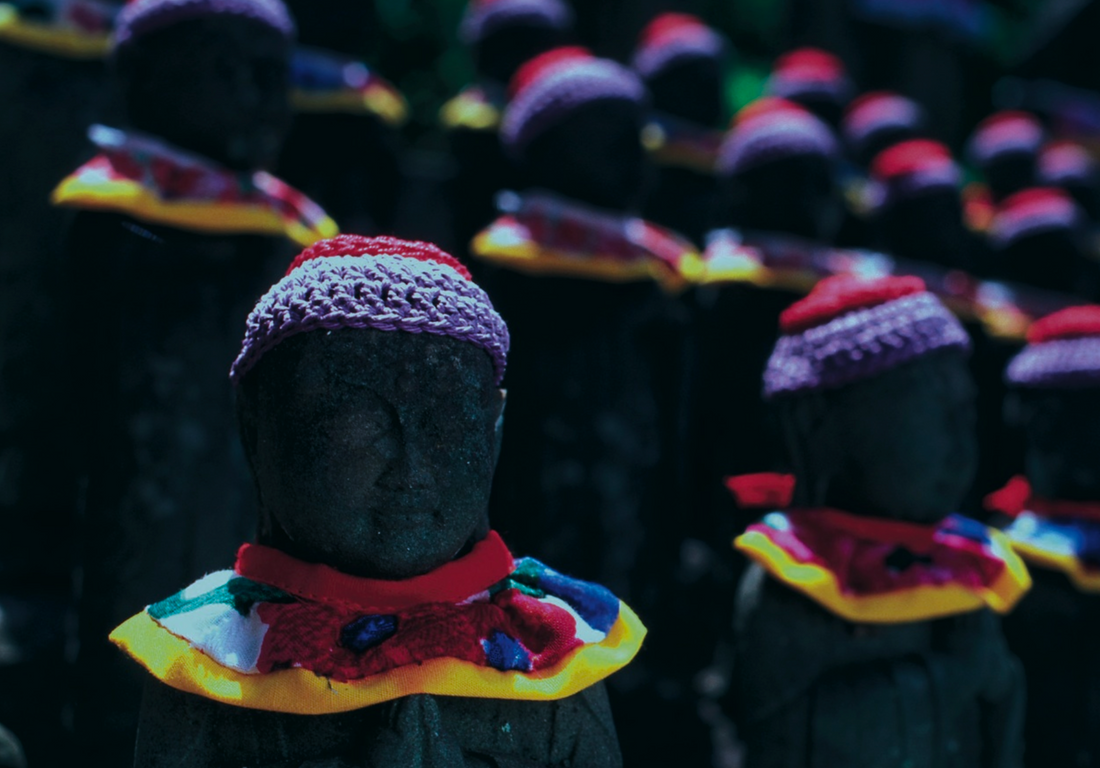
Children of the Waters
Layered deep in textiles the stone baby-faced statues wear bibs, knitted and crocheted hats or lovingly crafted bonnets. Some garments are made in miniature, a perfect fit to the tiny stone body, whilst others are clearly those once worn by actual infants. Some are eccentrically extravagant, others austere: many are weathered pale and fragile by the elements.They all exhibit an intriguing and unique use of textiles.
Jizo’s bibbed image can be seen across Japan but the Mizuko Jizo, typically dressed in red, are exclusively for foetuses and children who die early. Placed individually on street corners or grouped by the thousand at large temples, they are laden with clothing for children that will never be. These culturally jarring shrines are the somewhat controversial places of remembrance for the souls of miscarried, stillborn and aborted children or those that have died shortly after birth. Little detailed information regarding their use is written in the West. Perhaps in an attempt to keep the shrines intimate and private, apart from a couple of well documented temples in main cities it is difficult to find reliable directions to shrine locations. Efforts to visit these evocative sites can involve bewildering journeys following scant directions to areas outside the main cultural centres.
Individual sites have distinctive characteristics: at Zojoji Temple, Tokyo, many shrines show Jizo holding a plastic pinwheel that spins and rattles as the wind blows. At Hase Dera, Kamakura, Jizo holds the symbolic six-ringed staff 'shakujo' and the 'noshunotama' jewel. At Sanju-ichiban near Chichibu rows and rows of well-tended shrines flank the mountainsides. What all these statues, temples and rituals have in common is a set of practices originating in the 17th century that offer solace and ease the anguish surrounding the deaths of unborn and newborn babies. These rituals serve a double purpose. They are an expression of personal loss but for some they also offer a ritualised response to the widespread use of abortion in Japan. It has been said that these shrines affect the global perception of the issue and help diffuse the militant responses that characterise the debate in places like the US. But although contemporary comment has centred on the Mizuko Kuyo ceremony and the exchange of money between the remorseful women and the temple, Mizuko Jizos serve a wider purpose. They offer bereaved parents an established method of remembrance and an opportunity to grieve without a time limit. This has been denied to parents in the West where until recently the loss of an unborn child has often been diminished.
Day to day activity at the shrines includes the arrival of parents – indeed whole families – to place offerings and say prayers. Small toys are sometimes placed at the bases of the shrines and folk law suggest that water be offered. It is placed, in cartons, bottled or in 'Hello Kitty' cups, to assist the young spirit in its journey across the dried up riverbank of the land of Sai-no-Kawara, a place of limbo for Mizuko souls. In his book Liquid Life: Abortion and Buddhism in Japan, Professor William LaFleur provides a description of the fate of children lost very early in the life cycle: “Snatched from the ample and supportive existence within the environment of the amniotic fluid they are banished to the drought ridden 'hell' of the afterlife. Gathering at the riverbank they can no longer be with their beloved parents nor could they cross the shallow river that represented the boundary between them and rebirth.” But Jizo, who is honoured and invoked in these shines, is a protector of children. The long sleeves of his robe are a refuge, a place to hide and he works to ease the suffering and shorten the sentence of the children.
It is customary on the anniversary of the death of the child to make a new offering, and another piece of clothing is added. This cyclical ceremony can be repeated for decades, sometimes for the lifetime of the surviving parent, building layer upon layer of cloth. The physical process of dressing these shrines is apparent: threads, ribbons and straps tightly tie the garments onto this representation of the God that will protect the soul of the child in their afterlife. Exposed to the elements, the stone is inherently robust: but exposure to the elements brings about a deconstruction or decomposition of the textile structure which is an inevitable and poignant reminder of the natural cycle of life. Yet it is the loving touch from each parent that leaves the biggest impact when visiting these shrines: you are left with a vicarious feeling of sadness and grief for each lost child.
Text by Shelly Goldsmith
Photo courtesy of Jamie Marshall/ Tribal Eye.
Children of the Waters: Misuko Jizo shrines are an expression of a universal emotion - grief was published in issue 4: Celebrate of Selvedge Magazine.
